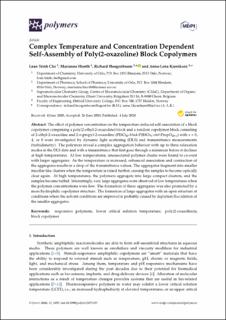Complex Temperature and Concentration Dependent Self-Assembly of Poly(2-oxazoline) Block Copolymers
Peer reviewed, Journal article
Published version

Åpne
Permanent lenke
https://hdl.handle.net/11250/2676078Utgivelsesdato
2020-07-04Metadata
Vis full innførselSamlinger
Sammendrag
The effect of polymer concentration on the temperature-induced self-association of a block copolymer comprising a poly(2-ethyl-2-oxazoline) block and a random copolymer block consisting of 2-ethyl-2-oxazoline and 2-n-propyl-2-oxazoline (PEtO80-block-P(EtOxx-stat-PropO40-x) with x = 0, 4, or 8 were investigated by dynamic light scattering (DLS) and transmittance measurements (turbidimetry). The polymers reveal a complex aggregation behavior with up to three relaxation modes in the DLS data and with a transmittance that first goes through a minimum before it declines at high temperatures. At low temperatures, unassociated polymer chains were found to co-exist with larger aggregates. As the temperature is increased, enhanced association and contraction of the aggregates results in a drop of the transmittance values. The aggregates fragment into smaller micellar-like clusters when the temperature is raised further, causing the samples to become optically clear again. At high temperatures, the polymers aggregate into large compact clusters, and the samples become turbid. Interestingly, very large aggregates were observed at low temperatures when the polymer concentrations were low. The formation of these aggregates was also promoted by a more hydrophilic copolymer structure. The formation of large aggregates with an open structure at conditions where the solvent conditions are improved is probably caused by depletion flocculation of the smaller aggregates.
